Fleas
Fleas are the most common external parasite we find on cats and dogs. They can easily be killed and infestations prevented by using veterinary ‘spot-on’ treatments. Here we tell you how to tell if your animal has fleas, how to treat them and also how to treat your home.
What are fleas?
Fleas are wingless insects, they have 6 legs and a thin, flat, brown body, which makes it easy for them to move between an animal’s hairs. There are 2 main species of fleas; Ctenocepalides Felis, the cat flea and Ctenocephalides Canis, the dog flea.
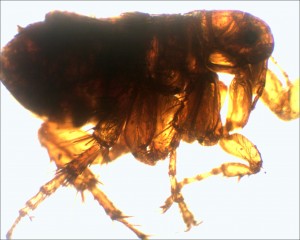
The Flea Lifecycle
The adult fleas account for only 5% of the total flea population. There are many more eggs, larvae and pupae in the flea’s environment. This is why, as well as treating your pet, it is important to treat the house too.
- Adult Flea – The flea infestation begins when the flea emerges from the pupae and takes a blood meal from your pet. Female fleas begin to lay eggs within 24 hours and can lay many hundreds in their 3 month lifetime!
- Eggs – the eggs are smooth and shiny and fall into the environment and hatch within 2-10 days
- Larvae – the larvae emerge from the eggs and crawl into cracks and crevices, they are often found in the carpet under furniture, where it is warm and dark.
- Pupae – the larvae becomes a pupae within 5-10 days. The silk-like cucoon protects the developing flea and can resist very low temperatures. The flea can remain like this for months, which is how they survive the winter outside. Increases in temperature, vibrations and increased carbon dioxide will cause the flea to emerge and the life cycle to continue.
The Flea Lifecycle
How do I tell if my pet has fleas?
There are many different symptoms your pet may show if they have fleas:
- Itching and scratching – this is the most common sign your pet has fleas. Dogs especially will scratch themselves a lot, often causing damage to the skin so it becomes scabby and sore. The most common places to scratch are the armpits, flanks, groin and back.
- Over grooming – this is more common in cats. When cats are itchy they are more likely to lick themselves than scratch like dogs. The most common sites are along their backs, where the hair are often short and coarse as the hair shafts have been broken, or in the groin where they can lick themselves bald.
- Scabs – some animals, especially if they are sensitive to flea bites, will develop multiple small scabs, most often over their backs. Each scab is where a flea has bitten.
- Fleas or flea dirt is seen – if you see fleas on your pet, this often means there is a heavy infestation as they are not often spotted. See below for how to check for flea dirt.
- You get bitten! – fleas will also bite people. The bites come up in small, red raised spots, often in a line over the legs or tummy, where the flea has had several meals!
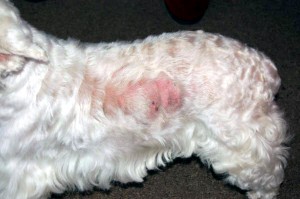
This dog has sore skin on it’s flanks, which is often a sign of flea infestations.
How do I check for flea dirt?
- Flea dirt is flea faeces and looks like small flecks of black sand on your pets coat, it is most commonly found at the back of the neck or the base of the tail.
- Comb out some flecks onto cotton wool or white toilet paper and dampen
- Flea dirt will go red when it is added to water, all fleas eat is blood, so all they produce is blood, it just looks black because it is dry.
- However, just because you don’t find flea dirt doesn’t mean your pet doesn’t have fleas! Cats will commonly groom out any signs of fleas from their coats, especially if they are itchy.
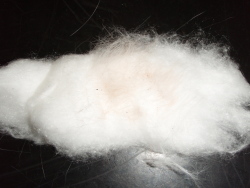
Flea dirt from an animal’s coat has been combed out onto this piece of cotton wool.
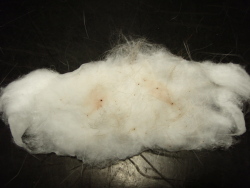
This is the same piece of cotton wool that has been dampened. It is easy to see how the black flecks have turned red, confirming them as flea dirt
How do I treat my pet for fleas?
- There are several ways to treat and protect your pet against fleas.
- Veterinary standard products are available as ‘spot-ons’, tablets or injections.
- Spot-ons are by far the most popular way of treating against fleas, they can have actions against both adults and the lifecycle, they are easy to apply, non-painful and can be done at home.
- We always advise using products only available from your vet, they work far better than anything from a supermarket or pet shop.
There are lots of different products on the market to kill and prevent fleas, your vet will be able to advise you on the best ones for you.
Why should I buy veterinary flea products?
Veterinary Strength products, which are only available from your vet or pharmacy, are much better than the ones you can buy in the supermarket or from a pet shop for several reasons:
- Veterinary products use modern chemicals to which the fleas are sensitive, products available over the counter often use older drugs which the fleas are resistant to.
- All veterinary products have 100% efficacy at killing fleas, this is not always the case with other flea preparations
- Most veterinary spot-ons also have an effect on the larval or egg stages of the fleas, meaning the life cycle is disrupted. Shop-bought products generally only kill the adult flea, but it will have laid many eggs and when these hatch they will simply re-infest your pet.
- Some veterinary spot-ons will contain ingredients that will also treat the house.
What about the house?
95% of the flea infestation in your home is the eggs, pupae and larval stages of the fleas life cycle. It is imperative you treat the house as well as your pet;
- Vacuuming – Give the house a really good vacuum and make sure to move the furniture. Fleas aren’t stupid, they hide where is is warm and dark! Hoovering under the furniture will remove a huge amount of the eggs and larvae, and in any cracks in the floor and around the skirting boards.
- Wash anything your pet has contact with that can be easily cleaned, such as their bed or favorite blanket.
- Use a veterinary strength spray on the carpets and any soft furnishings. They stop any remaining eggs from being able to develop and kill the adult flea. Most are effective for a whole year, so once it is done fleas cannot develop in your house for a full 12 months!
- Don’t forget the car! Treat the car, caravan, garage and anywhere else where you pet goes to ensure all the fleas are killed
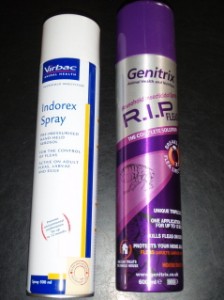
Use veterinary flea sprays on any carpets and soft furnishings, they can prevent fleas developing for up to a year
Please note, this is an advice only website. If you have any specific queries about your pet, please contact your vet.